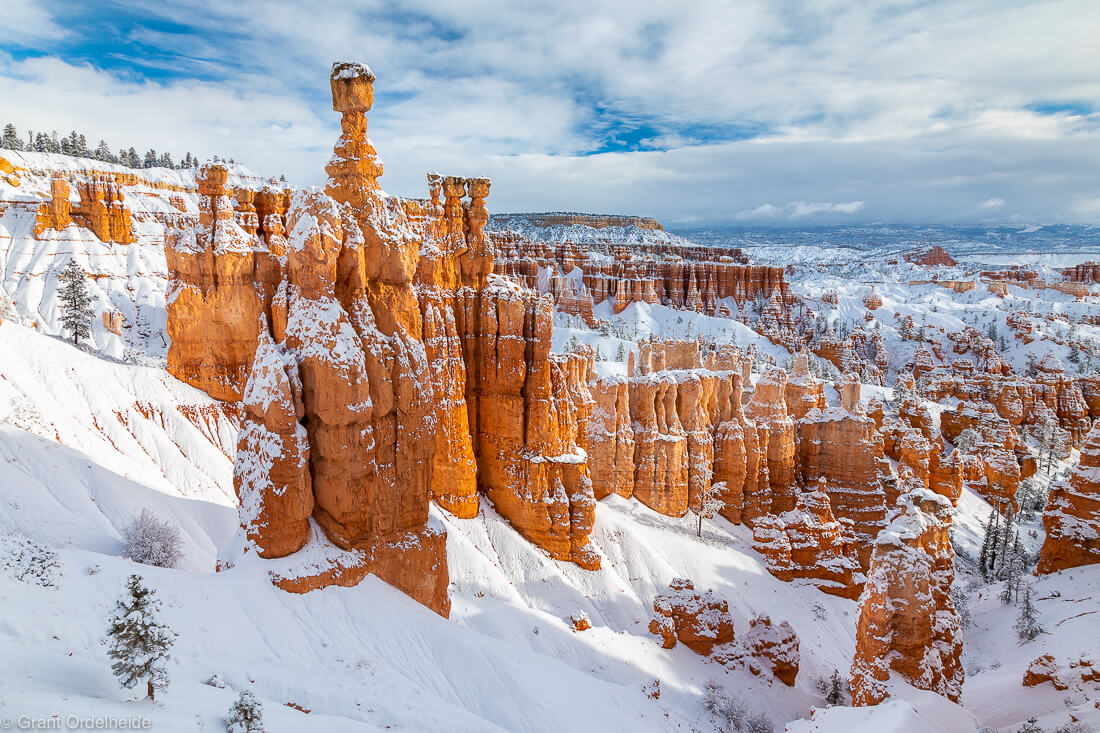If you are a landscape photographer, you likely have a love/hate relationship with winter photography. Winter is one of the best times to get out and shoot, but the logistics are much more challenging than in other seasons. Roads are slick, trails are covered, your camera gear doesn’t always work as well, and it can be miserably cold. Don’t let these obstacles keep your camera in the closet. Here are some tips to set yourself up for success in the dead of winter.
Gear
Gear is probably the most important consideration when getting out to shoot in winter. It may seem obvious, but keeping yourself warm is the first priority. Having cold fingers and toes will send you back inside before you can even turn on your camera. Bundle up and put on your heavy boots. For my hands, I like to use fingerless mittens. These allow me to free my fingers and operate the camera. If it is too cold out for bare fingers, try adding a pair of glove liners – ideally, ones that allow you to operate a touch screen.
A good pair of snowshoes or cross country skis are invaluable to winter photography. These pieces of gear will help you venture out farther and not be limited to plowed roads. These Tubbs Mountaineer Snowshoes are the pair I use, which are great for steeper angles and icier terrain.
Camera Challenges
Cold weather can also impact the way that your camera performs. It is unlikely you will be in temperatures that would damage your camera, but the cold can still affect the way things work. Batteries drain much faster in frigid temperatures. Keep extra batteries in your jacket, close to your body to keep them as warm as possible. If you are camping, put your batteries in your sleeping bag at night. A little extra effort to keep your batteries warm will help to ensure that you won’t have prematurely dead batteries.
Condensation is another issue to keep in mind when dealing with big changes in temperature. Bringing a cold camera inside to a warm building can create condensation on your lens/camera. Allowing a more gradual temperature change can help mitigate some of the condensation on your camera.
Winter Strategies
The best winter photos are taken just after a snowstorm when the snow is fresh, unspoiled, and abundant. Within days of a storm, even in cold environments, snow can start to falling off trees or melting off of south-facing slopes. The best time to be out photographing is right as a storm starts to break and clear away. This takes a little bit of planning and a little bit of luck to pull off. Pay attention to the weather, and if you have the flexibility, try to plan your visit to coincide with the clearing of a weather system. I prefer the Wunderground weather app to help predict storms.
Nothing is more frustrating than finding a perfect winter scene that has been thoroughly tracked out. To keep your photos of fresh snow free of footprints, take care to plan out what shots you want to take. Be careful about where you step or you might just find yourself turning around to see the perfect shot, only it now has your footprints in it. Have a strategy about the shots you want to take and the order in which to take them.
Photographing Snow

Shooting snow can be both rewarding and challenging, and as with most subjects, snow has both technical and creative challenges.
The primary technical challenge with photographing snow is getting the correct exposure. Oftentimes photos of snow will come out dark and underexposed. This is due to the camera’s light meter thinking that the snow needs to be exposed for middle gray. Middle gray is the tonal midpoint between black and white and is the basis for your camera’s light meter. Under most circumstances, middle gray (or the mid tones) is a good starting point for calculating exposure.
The problem with winter scenes is that snow is a very bright, and your camera thinks the exposure needs to turn those bright tones into mid-tones. This can easily be avoided by overexposing your images by 1/3 or 2/3 of a stop. You want the snow to be bright and white, but be careful not to overexpose too much and lose the detail. Keep a close eye on your histogram to make sure the exposure and all of the information is properly recorded.
In the same vein, it can be tricky to find the correct white balance when photographing snow. Snow, especially snow in the shade, tends to come out really blue. While some blue in the shadows looks natural and gives a “cool” feeling to your shot, too much can be unnatural and distracting. Always shoot in RAW so you have the ability to adjust the white balance in post-production.
Photographing snow also has creative challenges as well. Snow can simplify landscapes, which makes it even more important to have a good composition. Try to use the starkness of snow to your advantage to create images with strong contrast. Snow and ice can work as the main subject or as an accent to a larger scene, but regardless the same principles that would make any good photo (light, composition, subject) need to be there.
Most of all, have fun out there and stay warm!








